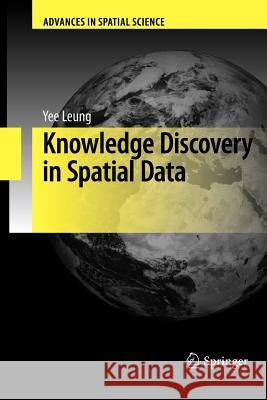Knowledge Discovery in Spatial Data » książka
Knowledge Discovery in Spatial Data
ISBN-13: 9783642261701 / Angielski / Miękka / 2012 / 360 str.
Knowledge Discovery in Spatial Data
ISBN-13: 9783642261701 / Angielski / Miękka / 2012 / 360 str.
(netto: 384,26 VAT: 5%)
Najniższa cena z 30 dni: 385,52 zł
ok. 22 dni roboczych
Bez gwarancji dostawy przed świętami
Darmowa dostawa!
When I ?rst came across the term data mining and knowledge discovery in databases, I was excited and curious to ?nd out what it was all about. I was excited because the term tends to convey a new ?eld that is in the making. I was curious because I wondered what it was doing that the other ?elds of research, such as statistics and the broad ?eld of arti?cial intelligence, were not doing. After reading up on the literature, I have come to realize that it is not much different from conventional data analysis. The commonly used de?nition of knowledge discovery in databases: "the non-trivial process of identifying valid, novel, potentially useful, and ultimately understandable patterns in data" is actually in line with the core mission of conventional data analysis. The process employed by conventional data analysis is by no means trivial, and the patterns in data to be unraveled have, of course, to be valid, novel, useful and understandable. Therefore, what is the commotion all about? Careful scrutiny of the main lines of research in data mining and knowledge discovery again told me that they are not much different from that of conventional data analysis. Putting aside data warehousing and database m- agement aspects, again a main area of research in conventional database research, the rest of the tasks in data mining are largely the main concerns of conventional data analysis.
This book deals with knowledge discovery and data mining in spatial and temporal data, seeking to present novel methods that can be employed to discover spatial structures and processes in complex data. Spatial knowledge discovery is examined through the tasks of clustering, classification, association/relationship, and process. Among the covered topics are discovery of spatial structures as natural clusters, identification of separation surfaces and extraction of classification rules from statistical and algorithmic perspectives, detecting local and global aspects of non-stationarity of spatial associations and relationships, unraveling scaling behaviors of time series data, including self-similarity and long range dependence. Particular emphasis is placed on the treatment of scale, noise, imperfection and mixture distribution. Numerical examples and a wide scope of applications are used throughout the book to substantiate the conceptual and theoretical arguments.











